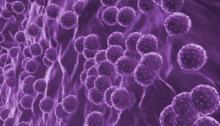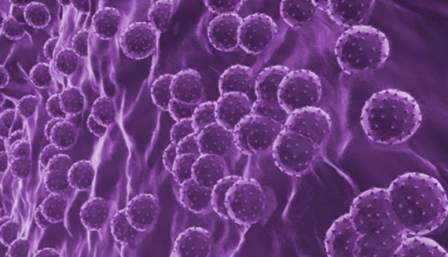User login
SAN FRANCISCO – Response-guided therapy using all-oral, triple direct-acting antiviral (DAA) therapy appears useful for shortening the duration of treatment in noncirrhotic patients with hepatitis C virus genotype 1b infection, according to findings from the randomized proof-of-concept SODAPI study.
The findings of the open-label study strongly suggest that administration of potent triple regimens containing NS3, NS5A, and NS5B HCV inhibitors leads to rapid virologic response within 2 days in a majority of treated patients, Dr. George K. Lau of Emory University, Atlanta, reported at the annual meeting of the American Association for the Study of Liver Diseases.
Study subjects were 26 Chinese patients who received either sofosbuvir, ledipasvir, and asunaprevir (group 1, 12 patients); sofosbuvir, daclatasvir, and simeprevir (group 2, 6 patients); or sofosbuvir, daclatasvir, and asunaprevir (group 3, 8 patients) at approved doses. Those who achieved rapid virologic response remained on the regimen for 3 weeks; those who did not were treated for 8-12 weeks.
Rapid virologic response was achieved by 6 of 12 group 1 patients, 6 of 6 group 2 patients, and 6 of 8 group 3 patients. Baseline viral load was lower in those with rapid virologic response vs. those without (5.96 vs. 7.00 log10 IU/mL), Dr. Lau noted.
All 18 subjects with rapid virologic response and 3 weeks of treatment achieved the primary endpoint of plasma HCV RNA below the detectable limit at 12 weeks (SVR12). Median time to plasma HCV RNA less than 25 IU/mL was shortest in group 1 vs. group 3, he said.
Treatment was well tolerated; no patients discontinued therapy and no significant adverse events were reported.
Patients in the study were noncirrhotic patients with chronic hepatitis C genotype 1b infection with a median age of 34 years, median body mass index of 21.7 kg/m2, and baseline mean HCV RNA of 6.55 log10 IU/mL. Six were men, 12 were women.
DAAs have a high cure rate and favorable tolerability in persons infected with hepatitis C virus, but shorter courses could improve adherence and affordability and could increase accessibility to DAAs, Dr. Lau said.
He and his colleagues “postulated that the addition of an NS3 protease inhibitor to dual NS5A-NS5B (nucleoside) inhibitors would enhance antiviral efficacy and reduce treatment duration to 3 weeks in those with a rapid virologic response defined as plasma HCV RNA less than 500 IU/mL by day 2.”
Based on these positive early findings, future studies exploring this response-guided approach to therapy are recommended, as this approach has the potential to reduce therapy duration and drug costs, and to improve accessibility and adherence, he concluded.
Dr. Lau is a consultant for Roche and Novartis.
SAN FRANCISCO – Response-guided therapy using all-oral, triple direct-acting antiviral (DAA) therapy appears useful for shortening the duration of treatment in noncirrhotic patients with hepatitis C virus genotype 1b infection, according to findings from the randomized proof-of-concept SODAPI study.
The findings of the open-label study strongly suggest that administration of potent triple regimens containing NS3, NS5A, and NS5B HCV inhibitors leads to rapid virologic response within 2 days in a majority of treated patients, Dr. George K. Lau of Emory University, Atlanta, reported at the annual meeting of the American Association for the Study of Liver Diseases.
Study subjects were 26 Chinese patients who received either sofosbuvir, ledipasvir, and asunaprevir (group 1, 12 patients); sofosbuvir, daclatasvir, and simeprevir (group 2, 6 patients); or sofosbuvir, daclatasvir, and asunaprevir (group 3, 8 patients) at approved doses. Those who achieved rapid virologic response remained on the regimen for 3 weeks; those who did not were treated for 8-12 weeks.
Rapid virologic response was achieved by 6 of 12 group 1 patients, 6 of 6 group 2 patients, and 6 of 8 group 3 patients. Baseline viral load was lower in those with rapid virologic response vs. those without (5.96 vs. 7.00 log10 IU/mL), Dr. Lau noted.
All 18 subjects with rapid virologic response and 3 weeks of treatment achieved the primary endpoint of plasma HCV RNA below the detectable limit at 12 weeks (SVR12). Median time to plasma HCV RNA less than 25 IU/mL was shortest in group 1 vs. group 3, he said.
Treatment was well tolerated; no patients discontinued therapy and no significant adverse events were reported.
Patients in the study were noncirrhotic patients with chronic hepatitis C genotype 1b infection with a median age of 34 years, median body mass index of 21.7 kg/m2, and baseline mean HCV RNA of 6.55 log10 IU/mL. Six were men, 12 were women.
DAAs have a high cure rate and favorable tolerability in persons infected with hepatitis C virus, but shorter courses could improve adherence and affordability and could increase accessibility to DAAs, Dr. Lau said.
He and his colleagues “postulated that the addition of an NS3 protease inhibitor to dual NS5A-NS5B (nucleoside) inhibitors would enhance antiviral efficacy and reduce treatment duration to 3 weeks in those with a rapid virologic response defined as plasma HCV RNA less than 500 IU/mL by day 2.”
Based on these positive early findings, future studies exploring this response-guided approach to therapy are recommended, as this approach has the potential to reduce therapy duration and drug costs, and to improve accessibility and adherence, he concluded.
Dr. Lau is a consultant for Roche and Novartis.
SAN FRANCISCO – Response-guided therapy using all-oral, triple direct-acting antiviral (DAA) therapy appears useful for shortening the duration of treatment in noncirrhotic patients with hepatitis C virus genotype 1b infection, according to findings from the randomized proof-of-concept SODAPI study.
The findings of the open-label study strongly suggest that administration of potent triple regimens containing NS3, NS5A, and NS5B HCV inhibitors leads to rapid virologic response within 2 days in a majority of treated patients, Dr. George K. Lau of Emory University, Atlanta, reported at the annual meeting of the American Association for the Study of Liver Diseases.
Study subjects were 26 Chinese patients who received either sofosbuvir, ledipasvir, and asunaprevir (group 1, 12 patients); sofosbuvir, daclatasvir, and simeprevir (group 2, 6 patients); or sofosbuvir, daclatasvir, and asunaprevir (group 3, 8 patients) at approved doses. Those who achieved rapid virologic response remained on the regimen for 3 weeks; those who did not were treated for 8-12 weeks.
Rapid virologic response was achieved by 6 of 12 group 1 patients, 6 of 6 group 2 patients, and 6 of 8 group 3 patients. Baseline viral load was lower in those with rapid virologic response vs. those without (5.96 vs. 7.00 log10 IU/mL), Dr. Lau noted.
All 18 subjects with rapid virologic response and 3 weeks of treatment achieved the primary endpoint of plasma HCV RNA below the detectable limit at 12 weeks (SVR12). Median time to plasma HCV RNA less than 25 IU/mL was shortest in group 1 vs. group 3, he said.
Treatment was well tolerated; no patients discontinued therapy and no significant adverse events were reported.
Patients in the study were noncirrhotic patients with chronic hepatitis C genotype 1b infection with a median age of 34 years, median body mass index of 21.7 kg/m2, and baseline mean HCV RNA of 6.55 log10 IU/mL. Six were men, 12 were women.
DAAs have a high cure rate and favorable tolerability in persons infected with hepatitis C virus, but shorter courses could improve adherence and affordability and could increase accessibility to DAAs, Dr. Lau said.
He and his colleagues “postulated that the addition of an NS3 protease inhibitor to dual NS5A-NS5B (nucleoside) inhibitors would enhance antiviral efficacy and reduce treatment duration to 3 weeks in those with a rapid virologic response defined as plasma HCV RNA less than 500 IU/mL by day 2.”
Based on these positive early findings, future studies exploring this response-guided approach to therapy are recommended, as this approach has the potential to reduce therapy duration and drug costs, and to improve accessibility and adherence, he concluded.
Dr. Lau is a consultant for Roche and Novartis.
AT THE LIVER MEETING 2015
Key clinical point: Response-guided therapy using all-oral, triple direct-acting antiviral therapy appears useful for shortening the duration of treatment in noncirrhotic patients with hepatitis C virus genotype 1b infection according to a proof-of-concept study.
Major finding: Rapid virologic response was achieved by 6 of 12 group 1 patients, 6 of 6 group 2 patients, and 6 of 8 group 3 patients; all 18 subjects with rapid virologic response achieved SVR12.
Data source: A randomized, open-label pilot study of 26 patients.
Disclosures: Dr. Lau is a consultant for Roche and Novartis.

